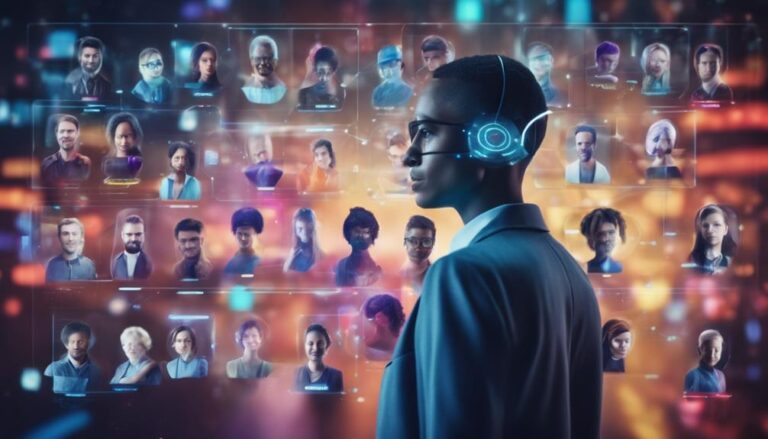By leveraging AI, I've honed customer segmentation to a new level of precision. Advanced algorithms let me categorize consumers by behaviors, demographics, and preferences, drawing from vast data sources like CRM systems and social media. This results in more targeted and personalized marketing campaigns, which greatly boost conversion rates. Machine learning detects hidden patterns, automating the process for efficiency and scalability. With real-time data analysis, I can instantly adjust strategies, providing a dynamic edge in customer engagement. The insights from predictive modeling further refine personalization efforts. To discover the profound impact AI can make, there's much more to explore.
Key Takeaways
- Utilize machine learning algorithms to detect hidden patterns in customer behavior for precise segmentation.
- Leverage extensive data sources like CRM systems and social media platforms to enhance segmentation accuracy.
- Implement real-time data processing to allow dynamic and adaptive customer segmentation.
- Employ predictive behavioral modeling to forecast customer preferences and optimize engagement.
- Ensure transparent data usage and robust privacy policies to build consumer trust.
AI in Customer Segmentation
In leveraging advanced algorithms, AI in customer segmentation categorizes consumers based on their behaviors, demographics, and preferences, drawing from extensive data sources like CRM systems and social media platforms.
By analyzing this data, AI enables precise targeting and the creation of personalized marketing campaigns. These campaigns often result in higher conversion rates due to their tailored approach.
By understanding customer behaviors through AI-driven insights, I can implement more efficient targeting strategies. Whether it's CRM systems or social media platforms, the data processed by AI helps me pinpoint specific audience segments with remarkable accuracy.
This transformation in customer segmentation practices allows for a deeper connection with the audience, ultimately driving engagement and achieving marketing goals more effectively.
How AI Enhances Personalization
AI's capacity for hyper-personalization transforms customer experiences by meticulously analyzing vast datasets to tailor marketing efforts. By leveraging AI-powered customer segmentation, I can create personalized experiences that resonate deeply with my audience.
Here's how:
- Machine learning algorithms detect hidden patterns in customer behavior, enabling precise segmentation.
- AI tools automate the segmentation process, making it efficient and scalable.
- Targeted marketing campaigns crafted from detailed customer behavior analysis boost customer engagement.
- Personalization driven by AI leads to increased conversion rates and improved ROI.
The ability to deliver hyper-personalization through AI not only enhances customer engagement but also ensures that every marketing effort is finely tuned to meet specific needs, translating directly to higher conversion rates.
Data-Driven Segmentation

Building on the power of AI-enhanced personalization, data-driven segmentation leverages sophisticated algorithms to meticulously analyze diverse datasets and uncover intricate customer patterns. By integrating demographic, behavioral, and psychographic data, I can create detailed customer profiles that facilitate targeted marketing strategies. AI algorithms enable real-time data processing, allowing for dynamic segmentation and truly personalized customer experiences. Tapping into CRM systems, website analytics, and social media data, data-driven segmentation enhances customer engagement and retention, forging the path for highly effective marketing campaigns. The precision of this approach guarantees that every marketing action is informed and impactful.
| Data Source | Benefit |
|---|---|
| Demographic Data | Identifies age, gender, income groups |
| Behavioral Data | Tracks purchase history, website activity |
| Psychographic Data | Understands lifestyle, values, interests |
| CRM Systems | Centralizes customer interactions |
| Social Media Data | Captures real-time customer sentiments |
Real-Time Customer Insights
I rely on AI to analyze real-time data streams, which gives me immediate insights into customer behavior. This capability allows me to adapt my marketing strategies instantaneously, ensuring my messages are always relevant.
Data-Driven Behavior Analysis
Leveraging real-time customer insights through data-driven behavior analysis allows businesses to craft highly personalized marketing strategies that resonate with individual consumer preferences. With AI algorithms, I can analyze customer behavior across multiple touchpoints, enabling dynamic segmentation.
Key data points such as:
- Browsing history
- Purchase patterns
- Social media interactions
- Real-time insights
drive this personalization. By constantly monitoring these interactions, I can adjust marketing tactics on the fly, enhancing customer engagement and conversion rates.
This evidence-based approach guarantees that each customer receives tailored experiences, making my marketing efforts more effective. The innovation lies in the precision and immediacy of these insights, transforming how I connect with consumers.
Instantaneous Market Adaptation
Instantaneous market adaptation thrives on the actionable insights derived from real-time customer data, enabling me to pivot strategies swiftly and effectively.
AI algorithms dissect evolving customer data, delivering immediate segmentation insights that sharpen personalized customer segmentation.
By monitoring customer behavior in real time, I can identify new opportunities for segmentation, guaranteeing that my messages remain timely and relevant.
This instantaneous market adaptation allows me to tailor marketing efforts precisely to target audiences, fostering increased engagement.
The ability to send timely messages based on the freshest data guarantees that my strategies aren't just reactive but proactively aligned with consumer needs.
Real-time customer insights powered by AI not only enhance personalization but also optimize overall marketing efficacy.
Predictive Behavioral Modeling

In the domain of personalized customer segmentation, predictive behavioral modeling employs advanced AI algorithms to forecast future customer actions based on historical data and interactions.
By analyzing data patterns, we can anticipate customer preferences, buying habits, and engagement levels. This technique enables businesses to:
- Forecast customer preferences: Understand and predict what customers might be interested in next.
- Deliver personalized experiences: Tailor marketing strategies and offers to individual customer needs.
- Implement targeted messaging: Send the right message to the right customer at the right time.
- Identify high-value customers: Focus efforts on those who are likely to convert, reducing churn and increasing conversion rates.
Benefits of AI Segmentation
Fundamentally, AI segmentation provides marketers with unparalleled accuracy and precision in identifying distinct customer segments, which leads to more effective and targeted marketing campaigns.
By leveraging advanced AI tools, I can handle large datasets efficiently, uncovering deeper customer understanding. This enables me to craft personalized marketing strategies that resonate with specific audience needs.
With AI-powered insights, I make informed decisions, optimizing campaigns for better performance. The ability to deliver highly targeted campaigns translates to increased engagement and improved conversion rates.
Ultimately, AI segmentation empowers me to maximize marketing impact through precise customer segmentation and tailored messaging, ensuring every campaign is strategically aligned with my audience's behaviors and preferences.
Implementing AI Solutions

Implementing AI solutions for customer segmentation demands a strategic approach to harness the full potential of machine learning algorithms and extensive data sets. To achieve this, I focus on:
- Data Collection: Gathering thorough customer data from diverse touchpoints.
- Algorithm Selection: Choosing the right machine learning algorithms for accurate segmentation.
- Integration: Seamlessly integrating AI tools into existing marketing systems.
- Testing and Optimization: Continuously evaluating and refining models for better performance.
Overcoming AI Challenges
Managing the complexities of AI for customer segmentation demands addressing data privacy, talent acquisition, and ethical considerations head-on. Data privacy concerns are paramount, with 80% of customers more likely to trust companies that transparently explain data usage. Skilled talent is another hurdle; 78% of organizations struggle to find AI professionals. AI bias must be mitigated, as 63% of consumers hold companies accountable for fair AI practices. Investing in ethical AI practices is crucial, as 94% of executives agree it's vital for AI adoption. Overcoming these challenges paves the way for personalized experiences and revenue growth, with AI-driven companies being 1.5 times more likely to see over 10% revenue increases.
| Challenge | Statistic |
|---|---|
| Data Privacy Concerns | 80% trust with transparent usage |
| Skilled Talent | 78% struggle to find professionals |
| Ethical AI Practices | 94% executives find it important |
Frequently Asked Questions
What Is the Role of Artificial Intelligence in Personalized Customer Experience?
AI's role in personalized customer experience includes behavioral analysis, sentiment tracking, and engagement metrics. By leveraging predictive insights, dynamic content, data mining, and real-time personalization, AI enhances the customer journey through predictive analytics and user profiling.
How Can Artificial Intelligence Be Used to Create More Personalized Marketing Campaigns to Consumers?
When I used AI for a campaign, data analysis and predictive modeling revealed customer insights and behavioral patterns. Sentiment analysis and purchase history informed targeted advertising and content recommendations, aligning with consumer behavior and market trends for best results.
How Does AI Help in Personalized Shopping?
AI enhances personalized shopping by using predictive modeling and behavioral analysis to offer product recommendations. Sentiment analysis and purchase history refine engagement metrics, while dynamic pricing and demand forecasting boost customer retention through trend identification and optimized sales.
What Is AI Powered Personalization?
AI-powered personalization is like a masterful orchestra conductor. Using machine learning, data analysis, predictive modeling, and sentiment analysis, I can identify segments, understand behavioral patterns, and provide real-time personalization, optimizing algorithms for precise customer insights and user profiling.
Conclusion
Harnessing AI's power for personalized customer segmentation isn't just a trend; it's a game-changer. While traditional methods rely on guesswork, AI leverages real-time data, providing precise insights.
It's like comparing a candle to a floodlight; one barely illuminates, the other reveals everything. With predictive behavioral modeling, we don't just react; we anticipate.
The benefits are clear: targeted marketing, enhanced customer experiences, and increased loyalty. Implementing AI isn't without challenges, but the rewards far outweigh the hurdles.






